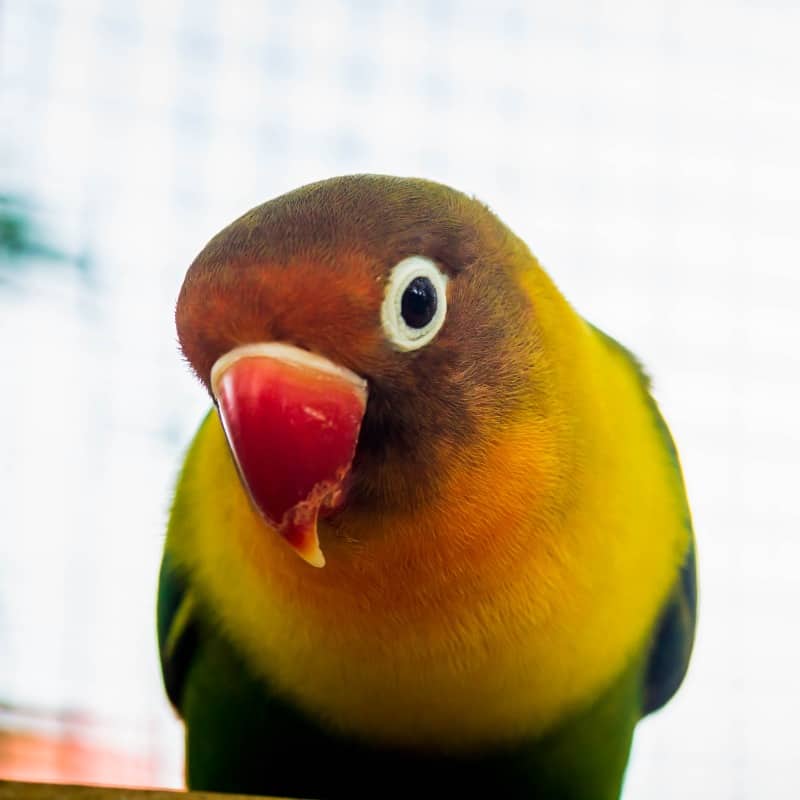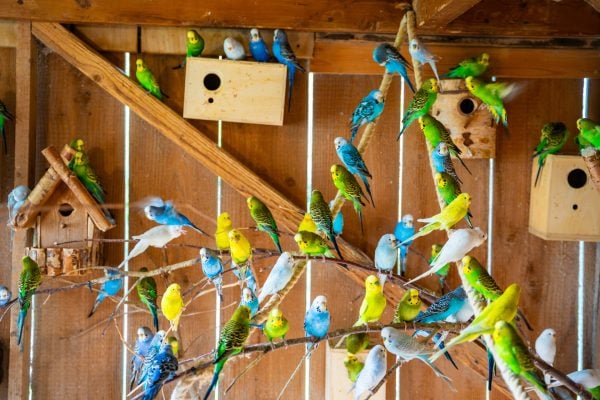Last Updated on by Catherine Tobsing
Parrotlets and lovebirds may appear remarkably similar upon initial observation. Back in the 1800s, when parrotlets were first encountered – an entire century after Europeans became acquainted with lovebirds – they were dubbed South American lovebirds.
This moniker implied that lovebirds, hailing from Africa, were a world apart from their newfound South American counterparts.
So, what connects these diminutive, stub-tailed avians from disparate lands, and what sets them apart?
Comparison: Spirited Nature
Lovebirds and parrotlets are characterized as small creatures with a big presence.
Unaware of their size, they fearlessly socialize with and even challenge birds much larger than themselves. Occasionally labeled as nippy, they can still make loving companions if raised by hand.
To maintain their affectionate nature, daily handling is necessary for pet birds of both these varieties.
Or risk being a companion to a pair of flying scissors.
Getting a lovebird or parrotlet companion requires a serious commitment.
Despite their fondness for attention and affection, both species do not thrive in the company of another bird.
It is best to either have one as a pet or maintain multiple birds in individual cages to ensure their well-being.
According to Sandee Molenda, co-founder of the International Parrotlet Society, the intense affection and loyalty exhibited by both species towards their owners can result in feelings of envy towards other individuals or pets residing in the same household.
Interestingly, Molenda states that females of both parrotlets and lovebirds tend to display higher levels of aggression compared to their male counterparts.
Lovebirds and parrotlets possess not only audacious and spirited personalities but also exhibit intelligence.
Lovebirds, in particular, are notorious for their knack for unraveling the secrets of unlocking cage doors or accessing food cups, thus liberating themselves from captivity.
Variation: Magnitude
Parrotlets commonly raised as companions encompass three distinct species – the Pacific parrotlet, the green-rumped parrotlet, and the spectacled parrotlet.
Their dimensions range from 3 inches to 5 1/2 inches in size, while their weight fluctuates between 18 to 28 grams.
Contrarily, lovebirds like the peach-faced, masked, and Fischer’s lovebirds measure 5 to 6 inches in length, displaying a robust figure with a weight spanning from 35 to 55 grams.
Lovebirds and parrotlets, although both diminutive in size, differ in their proportions; parrotlets are approximately two-thirds the size of their lovebird counterparts.
To our knowledge, the anticipated life span of both species ranges from 15 to 20 years. Lovebirds have been in captivity for a longer duration compared to parrotlets, hence we are still acquiring knowledge about the longevity of the latter.
Additionally, due to their small stature, excessive energy, and inquisitive nature, both species are prone to accidents, which also impacts their actual life span.
Distinctiveness: Sexual Dimorphism Rewrite: Variance: Sexual Dimorphism
Lovebirds, unlike many other parrot species, do not exhibit sexual dimorphism. This means that both male and female lovebirds share the same physical features. However, as parrotlets reach maturity, they develop distinct visual characteristics that differentiate between the two sexes.
Contrast: Expressions
While lovebirds possess a shrill and piercing natural call, parrotlets emit soft and melodic chirps while lacking the ability to let out a loud squawk.
Although generally silent, parrotlets have the potential to pick up speech, with the spectacled parrotlet being known as the most proficient talker in its species. Lovebirds hardly ever imitate sounds or engage in verbal communication.
Comparison: Action
Parrotlets and lovebirds, both vibrant and playful creatures, display remarkable activity levels and inquisitive natures. Their acrobatic skills are truly a sight to behold as they dangle from their toys, indulging in their curious nature. Furthermore, these delightful beings not only seek companionship but also a sense of adventure.
They enjoy perching on their human’s shoulder or even taking refuge amidst their person’s tresses, occasionally even finding solace within a cozy pocket.
According to Dena Tucker from CreativeBirdToys.com, both lovebird and parrotlet guardians exhibit a shared fondness for purchasing toys adorned with a plethora of colorful components.
Moreover, their preferred toys often emit stimulating noises and possess an engaging shredding potential.
Their resilience and powerful beaks make them suitable for toys that cater to the size of cockatiels or conures, rather than budgies. Despite their small stature, these birds possess a significant presence!
Lovebirds and parrotlets both find pleasure in having a swing at their disposal. It should be noted, however, that while these birds do exhibit curiosity towards enclosed spaces such as boxes or tents, introducing such items may inadvertently trigger territorial breeding tendencies in mature birds.
Therefore, it is advisable to refrain from offering these items to lovebirds and parrotlets.
Variation: Nesting Habit
Should you own a female peach-faced lovebird, you may observe her engaging in a unique and fascinating behavior. It involves her tearing apart various objects such as paper or palm fronds, and then cleverly arranging them within her feathers around her rump.
This results in a rather peculiar yet captivating sight as she gracefully soars or strolls around adorned in her self-created decorations. Interestingly, this particular nesting habit is exclusive to peach-faced lovebirds and is not exhibited by other types of lovebirds or parrotlets.
Comparison: Varied forms of life
Before bringing home a pet, it is essential to acquaint oneself with the different species available. Among the types commonly chosen as pets, there exist three varieties of lovebirds: the peach-faced, masked, and Fischer’s.
Similarly, three distinct species of parrotlets are often kept as pets: the Pacific, green-rumped, and spectacle. Familiarizing oneself with the characteristics and traits of these species is crucial when considering a chosen pet.
A Plethora of vibrant mutations characterizes the enchanting world of Peach-faced lovebirds as delightful companions in the realm of pets.
Unlike their counterparts, masked lovebirds and Fischer’s lovebirds, which may start off as gentle while young but fail to retain their tamed nature, the Peach-faced lovebirds consistently maintain their docility.
Many individuals choose to own Pacific parrotletts due to the availability of various mutation colors. While possessing a feisty and stubborn nature, these birds also exhibit deep affection towards their owners.
On the other hand, spectacle parrotlets are known for their boldness, with the unique ability for both males and females to acquire speech.
Conversely, green-rumped parrotlets may initially exhibit shyness; however, with the right amount of patience, they have the potential to become exceptional pets.
Variation: Providing sustenance
Parrotlets, being highly energetic creatures, require a higher calorie intake compared to lovebirds or even a larger, inactive cockatiel.
Lovebirds greatly enjoy having the chance to cleanse themselves, so it’s crucial to offer them more bathing opportunities. Spraying them with a plant mister or presenting a shallow dish of water for them to indulge in are both methods that most lovebirds truly appreciate.
Written and Approved by the Windy City Parrot Content Team
Author Profile
Latest entries
 The Traveling BirdJune 26, 2025Can You Name 5 Parrot Species That Are Living Wild in the USA?
The Traveling BirdJune 26, 2025Can You Name 5 Parrot Species That Are Living Wild in the USA? Bird BehaviorJune 26, 2025How is it Parrots Are Problem Solvers Social Animals and Even Use Tools?
Bird BehaviorJune 26, 2025How is it Parrots Are Problem Solvers Social Animals and Even Use Tools? Bird & Parrot AnatomyJune 25, 2025How a Tiny Chemical Modification Makes Parrots Nature’s Living Paintings
Bird & Parrot AnatomyJune 25, 2025How a Tiny Chemical Modification Makes Parrots Nature’s Living Paintings PigeonsJune 20, 2025How Do Parrots Thrive in Cities Outside Their Native Habitats?
PigeonsJune 20, 2025How Do Parrots Thrive in Cities Outside Their Native Habitats?




